Dense Water Formation in the North–Central Aegean Sea during Winter 2021–2022
Abstract
:1. Introduction

2. Materials and Methods
2.1. Hydrographic Data
2.2. Model Description and Performance
2.3. Atmospheric Forcing
3. Results
3.1. Recent Thermohaline State of the NCAeg
3.2. Surface Buoyancy Fluxes and Water Mass Transformation
3.3. Observations from Argo Floats 297 and 298
3.4. DWF Evolution from Model Output
3.5. One-Dimensionality of the Water Column
3.6. Turbulence inside the Mixed Layer
3.7. Export of Dense Water towards the SAeg
4. Discussion
5. Conclusions
Supplementary Materials
Author Contributions
Funding
Institutional Review Board Statement
Informed Consent Statement
Data Availability Statement
Acknowledgments
Conflicts of Interest
Abbreviations
| BSW | Black Sea Water |
| CMEMS | Copernicus Marine Environment Monitoring Service |
| DWF | Dense Water Formation |
| EMDW | Eastern Mediterranean Deep Water |
| EMed | Eastern Mediterranean Sea |
| EMT | Eastern Mediterranean Transient |
| LIW | Levantine Intermediate Water |
| LSW | Levantine Surface Water |
| MAW | Modified Atlantic Water |
| MLD | Mixed Layer Depth |
| NAG | North Aegean Sea Model |
| NCAeg | North–Central Aegean Sea |
| SAeg | South Aegean Sea |
| SST | Sea Surface Temperature |
| TMW | Transitional Mediterranean Water |
References
- Malanotte-Rizzoli, P.; Hecht, A. Large-scale properties of the Eastern Mediterranean—A review. Oceanol. Acta 1988, 11, 323–335. [Google Scholar]
- Malanotte-Rizzoli, P.; Robinson, A.R. POEM: Physical Oceanography of the Eastern Miditerranean. Eos Trans. Am. Geophys. Union 1988, 69, 194–203. [Google Scholar] [CrossRef]
- Georgopoulos, D.; Theocharis, A.; Zodiatis, G. Intermediate water formation in the Cretan Sea (south Aegean Sea). Oceanol. Acta 1989, 12, 353–359. [Google Scholar]
- Malanotte-Rizzoli, P.; Manca, B.; d’Alcala, M.R.; Theocharis, A. The Eastern Mediterranean in the 80’s and in the 90’s: The big transition emerged from the POEM-BC observational evidence. In The Eastern Mediterranean as a Laboratory Basin for the Assessment of Contrasting Ecosystems; Malanotte-Rizzoli, P., Eremeev, V.N., Eds.; NATO Science Series 2: Environmental Security; Springer: Dordrecht, The Netehrlands, 1999; Volume 51, pp. 1–6. [Google Scholar] [CrossRef]
- Gertman, I.; Ovchinnikov, I.; Popov, Y.I. Deep water formation in the Aegean Sea. Rapp. Comm. Int. Mer Médit. 1990, 32, 164. [Google Scholar]
- Theocharis, A.; Georgopoulos, D. Dense water formation over the Samothraki and Limnos Plateaux in the north Aegean Sea (Eastern Mediterranean Sea). Cont. Shelf Res. 1993, 13, 919–939. [Google Scholar] [CrossRef]
- Zervakis, V.; Georgopoulos, D.; Drakopoulos, P.G. The role of the North Aegean in triggering the recent Eastern Mediterranean climatic changes. J. Geophys. Res. Oceans 2000, 105, 26103–26116. [Google Scholar] [CrossRef]
- Yüce, H. Northern Aegean Water Masses. Estuar. Coast. Shelf Sci. 1995, 41, 325–343. [Google Scholar] [CrossRef]
- Krestenitis, Y.N.; Valioulis, I.A. Investigation of the deep water formation in the N. Aegean Sea basin. WIT Trans. Ecol. Environ. 1994, 8, 107–114. [Google Scholar]
- Roether, W.; Manca, B.B.; Klein, B.; Bregant, D. Recent changes in eastern Mediterranean deep waters. Science 1996, 271, 333–335. [Google Scholar] [CrossRef]
- Theocharis, A.; Klein, B.; Nittis, K.; Roether, W. Evolution and status of the Eastern Mediterranean Transient (1997–1999). J. Mar. Syst. 2002, 33–34, 91–116. [Google Scholar] [CrossRef]
- Zervakis, V. Ocean Obs: Mediterranean circulation and thermohalne functioning during the instrumental period. In Proceedings of the International MedCLIVAR-ICTP-ENEA Summer School on the Mediterranean Climate System and Regional Climate Change, Trieste, Italy, 13–22 September 2010; pp. 1–14. [Google Scholar]
- Lascaratos, A.; Roether, W.; Nittis, K.; Klein, B. Recent changes in deep water formation and spreading in the eastern Mediterranean Sea: A review. Prog. Oceanogr. 1999, 44, 5–36. [Google Scholar] [CrossRef]
- Drakopoulos, P.; Lascaratos, A. Modelling the Mediterranean Sea: Climatological forcing. J. Mar. Syst. 1999, 20, 157–173. [Google Scholar] [CrossRef]
- Korres, G.; Lascaratos, A. A one-way nested eddy resolving model of the Aegean and Levantine basins: Implementation and climatological runs. Ann. Geophys. 2003, 21, 205–220. [Google Scholar] [CrossRef]
- Triantafyllou, G.; Korres, G.; Petihakis, G.; Pollani, A.; Lascaratos, A. Assessing the phenomenology of the Cretan Sea shelf area using coupling modelling techniques. Ann. Geophys. 2003, 21, 237–250. [Google Scholar] [CrossRef]
- Nittis, K.; Lascaratos, A.; Theocharis, A. Dense water formation in the Aegean Sea: Numerical simulations during the Eastern Mediterranean Transient. J. Geophys. Res. Oceans 2003, 108, 8120. [Google Scholar] [CrossRef]
- Ilyin, Y.P.; Lemeshko, E.M.; Stanichny, S.V.; Soloviev, D.M. Satellite observations of similar circulation features in semi-enclosed basins of the Eastern Mediterranean with respect to marine ecosystems investigations. In The Eastern Mediterranean as a Laboratory Basin for the Assessment of Contrasting Ecosystems; Malanotte-Rizzoli, P., Eremeev, V.N., Eds.; NATO Science Series 2: Environmental Security; Springer: Dordrecht, The Netherlands, 1999; Volume 51, pp. 417–422. [Google Scholar] [CrossRef]
- Ayoub, N.; Traon, P.Y.L.; Mey, P.D. A description of the Mediterranean surface variable circulation from combined ERS-1 and TOPEX/POSEIDON altimetric data. J. Mar. Syst. 1998, 18, 3–40. [Google Scholar] [CrossRef]
- Pujol, M.I.; Larnicol, G. Mediterranean sea eddy kinetic energy variability from 11 years of altimetric data. J. Mar. Syst. 2005, 58, 121–142. [Google Scholar] [CrossRef]
- Nittis, K.; Zervakis, V.; Perivoliotis, L.; Papadopoulos, A.; Chronis, G. Operational monitoring and forecasting in the Aegean Sea: System limitations and forecasting skill evaluation. Mar. Pollut. Bull. 2001, 43, 154–163. [Google Scholar] [CrossRef] [PubMed]
- Zervakis, V.; Theocharis, A.; Georgopoulos, D. Circulation and hydrography of the open seas. In State of the Hellenic Marine Environment; Papathanasiou, E., Zenetos, A., Eds.; Hellenic Center for Marine Research: Gournes, Greece, 2005; pp. 104–123. [Google Scholar]
- Poulos, S.E.; Drakopoulos, P.G.; Collins, M.B. Seasonal variability in sea surface oceanographic conditions in the Aegean Sea (Eastern Mediterranean): An overview. J. Mar. Syst. 1997, 13, 225–244. [Google Scholar] [CrossRef]
- Sofianos, S.; Skliris, N.; Vervatis, V.; Olson, D.; Kourafalou, V.; Lascaratos, A.; Johns, W. On the forcing mechanisms of the Aegean Sea surface circulation. Geophys. Res. Abstr. 2005, 7, 04223. [Google Scholar]
- Theodorou, A.; Theocharis, A.; Balopoulos, E. Circulation in the Cretan Sea and adjacent regions in late winter 1994. Ocean. Acta 1997, 20, 585–596. [Google Scholar]
- Georgopoulos, D.; Chronis, G.; Zervakis, V.; Lykousis, V.; Poulos, S.; Iona, A. Hydrology and circulation in the Southern Cretan Sea during the CINCS experiment (May 1994-September 1995). Prog. Oceanogr. 2000, 46, 89–112. [Google Scholar] [CrossRef]
- Theocharis, A.; Balopoulos, E.; Kioroglou, S.; Kontoyiannis, H.; Iona, A. A synthesis of the circulation and hydrography of the South Aegean Sea and the Straits of the Cretan Arc (March 1994–January 1995). Prog. Oceanogr. 1999, 44, 469–509. [Google Scholar] [CrossRef]
- Androulidakis, Y.S.; Kourafalou, V.H. Evolution of a buoyant outflow in the presence of complex topography: The Dardanelles plume (North Aegean Sea). J. Geophys. Res. Oceans 2011, 116, C04019. [Google Scholar] [CrossRef]
- Velaoras, D.; Krokos, G.; Theocharis, A. Recurrent intrusions of transitional waters of Eastern Mediterranean origin in the Cretan Sea as a tracer of Aegean Sea dense water formation events. Prog. Oceanogr. 2015, 135, 113–124. [Google Scholar] [CrossRef]
- Malanotte-Rizzoli, P.; Manca, B.B.; d’Alcala, M.R.; Theocharis, A.; Brenner, S.; Budillon, G.; Ozsoy, E. The Eastern Mediterranean in the 80s and in the 90s: The big transition in the intermediate and deep circulations. Dyn. Atmos. Oceans 1999, 29, 365–395. [Google Scholar] [CrossRef]
- Wu, P.; Haines, K.; Pinardi, N. Toward an understanding of deep-water renewal in the eastern Mediterranean. J. Phys. Oceanogr. 2000, 30, 443–458. [Google Scholar] [CrossRef]
- Klein, B.; Roether, W.; Manca, B.; Theocharis, A. The evolution of the Eastern Mediterranean Climatic transient during the last decade: The tracer viewpoint. Rapp. Comm. Int. Mer Médit. 2000, 10, 21–25. [Google Scholar]
- Brankart, J.M.; Pinardi, N. Abrupt cooling of the Mediterranean Levantine intermediate water at the beginning of the 1980s: Observational evidence and model simulation. J. Phys. Oceanogr. 2001, 31, 2307–2320. [Google Scholar] [CrossRef]
- Skliris, N.; Sofianos, S.; Gkanasos, A.; Mantziafou, A.; Vervatis, V.; Axaopoulos, P.; Lascaratos, A. Decadal scale variability of sea surface temperature in the Mediterranean Sea in relation to atmospheric variability. Ocean Dyn. 2012, 62, 13–30. [Google Scholar] [CrossRef]
- Papadopoulos, V.P.; Kontoyiannis, H.; Ruiz, S.; Zarokanellos, N. Influence of atmospheric circulation on turbulent air-sea heat fluxes over the Mediterranean Sea during winter. J. Geophys. Res. Oceans 2012, 117, C03044. [Google Scholar] [CrossRef]
- Romanski, J.; Romanou, A.; Bauer, M.; Tselioudis, G. Atmospheric forcing of the Eastern Mediterranean Transient by midlatitude cyclones. Geophys. Res. Lett. 2012, 39, L03703. [Google Scholar] [CrossRef]
- Samuel, S.; Haines, K.; Josey, S.; Myers, P.G. Response of the Mediterranean Sea thermohaline circulation to observed changes in the winter wind stress field in the period 1980–1993. J. Geophys. Res. Oceans 1999, 104, 7771–7784. [Google Scholar] [CrossRef]
- Boscolo, R.; Bryden, H. Causes of long-term changes in Aegean sea deep water. Oceanol. Acta 2001, 24, 519–527. [Google Scholar] [CrossRef]
- Skliris, N.; Lascaratos, A. Impacts of the Nile River damming on the thermohaline circulation and water mass characteristics of the Mediterranean Sea. J. Mar. Syst. 2004, 52, 121–143. [Google Scholar] [CrossRef]
- Vervatis, V.; Skliris, N.; Sofianos, S. Inter-annual/decadal variability of the north Aegean Sea hydrodynamics over 1960–2000. Mediterr. Mar. Sci. 2014, 15, 696–705. [Google Scholar] [CrossRef]
- Velaoras, D.; Lascaratos, A. North–Central Aegean Sea surface and intermediate water masses and their role in triggering the Eastern Mediterranean Transient. J. Mar. Syst. 2010, 83, 58–66. [Google Scholar] [CrossRef]
- Beuvier, J.; Sevault, F.; Herrmann, M.; Kontoyiannis, H.; Ludwig, W.; Rixen, M.; Stanev, E.; Béranger, K.; Somot, S. Modeling the Mediterranean Sea interannual variability during 1961–2000: Focus on the Eastern Mediterranean Transient. J. Geophys. Res. Oceans 2010, 115, C08017. [Google Scholar] [CrossRef]
- Lagouvardos, K.; Kotroni, V.; Kallos, G. An extreme cold surge over the Greek peninsula. Q. J. R. Meteorol. Soc. 1998, 124, 2299–2327. [Google Scholar] [CrossRef]
- Vervatis, V.D.; Sofianos, S.S.; Skliris, N.; Somot, S.; Lascaratos, A.; Rixen, M. Mechanisms controlling the thermohaline circulation pattern variability in the Aegean–Levantine region. A hindcast simulation (1960–2000) with an eddy resolving model. Deep Sea Res. Part I Oceanogr. Res. Pap. 2013, 74, 82–97. [Google Scholar] [CrossRef]
- Tragou, E.; Zervakis, V.; Papadopoulos, A.; Maderich, V.; Georgopoulos, D.; Theocharis, A. Buoyancy transport through the Aegean Sea. In Proceedings of the 2nd International Conference on Oceanography of the Eastern Mediterranean and Black Sea: Similarities and Differences of Two Interconnected Basins, Ankara, Turkey, 14–18 October 2003; pp. 38–46. [Google Scholar]
- Androulidakis, Y.S.; Kourafalou, V.H.; Krestenitis, Y.N.; Zervakis, V. Variability of deep water mass characteristics in the North Aegean Sea: The role of lateral inputs and atmospheric conditions. Deep Sea Res. Part I Oceanogr. Res. Pap. 2012, 67, 55–72. [Google Scholar] [CrossRef]
- Velaoras, D.; Papadopoulos, V.P.; Kontoyiannis, H.; Papageorgiou, D.K.; Pavlidou, A. The Response of the Aegean Sea (Eastern Mediterranean) to the Extreme 2016–2017 Winter. Geophys. Res. Lett. 2017, 44, 9416–9423. [Google Scholar] [CrossRef]
- Vervatis, V.D.; Sofianos, S.S.; Theocharis, A. Distribution of the thermohaline characteristics in the Aegean Sea related to water mass formation processes (2005–2006 winter surveys). J. Geophys. Res. Oceans 2011, 116, C09034. [Google Scholar] [CrossRef]
- Roether, W.; Klein, B.; Hainbucher, D. The Eastern Mediterranean Transient: Evidence for similar events previously? In The Mediterranean Sea: Temporal Variability and Spatial Patterns; Borzelli, G.L.E., Gačić, M., Lionello, P., Malanotte-Rizzoli, P., Eds.; Number 202 in Geophysical Monograph Series; John Wiley & Sons Inc.: Hoboken, NJ, USA, 2014; pp. 75–83. [Google Scholar] [CrossRef]
- Cardin, V.; Civitarese, G.; Hainbucher, D.; Bensi, M.; Rubino, A. Thermohaline properties in the Eastern Mediterranean in the last three decades: Is the basin returning to the pre-EMT situation? Ocean Sci. 2015, 11, 53–66. [Google Scholar] [CrossRef]
- Tanhua, T.; Hainbucher, D.; Schroeder, K.; Cardin, V.; Álvarez, M.; Civitarese, G. The Mediterranean Sea system: A review and an introduction to the special issue. Ocean Sci. 2013, 9, 789–803. [Google Scholar] [CrossRef]
- Malanotte-Rizzoli, P.; Manca, B.B.; d’Alcalá, M.R.; Theocharis, A.; Bergamasco, A.; Bregant, D.; Budillon, G.; Civitarese, G.; Georgopoulos, D.; Michelato, A.; et al. A synthesis of the Ionian Sea hydrography, circulation and water mass pathways during POEM-phase I. Prog. Oceanogr. 1997, 39, 153–204. [Google Scholar] [CrossRef]
- Manca, B.; Theocharis, A.; Brenner, S.; Kontoyiannis, H.; Sansone, E. Water masses and transports between the Aegean and Levantine Basins during LIWEX ’95. In The Eastern Mediterranean as a Laboratory Basin for the Assessment of Contrasting Ecosystems; Malanotte-Rizzoli, P., Eremeev, V.N., Eds.; NATO Science Series 2: Environmental Security; Springer: Dordrecht, The Netherlands, 1999; Volume 51, pp. 483–494. [Google Scholar] [CrossRef]
- Klein, B.; Roether, W.; Manca, B.B.; Bregant, D.; Beitzel, V.; Kovacevic, V.; Luchetta, A. The large deep water transient in the Eastern Mediterranean. Deep Sea Res. Part I Oceanogr. Res. Pap. 1999, 46, 371–414. [Google Scholar] [CrossRef]
- Klein, B.; Roether, W.; Civitarese, G.; Gacic, M.; Manca, B.B.; d’Alcala, M.R. Is the Adriatic returning to dominate the production of Eastern Mediterranean Deep Water. Geophys. Res. Lett. 2000, 27, 3377–3380. [Google Scholar] [CrossRef]
- Civitarese, G.; Gačić, M.; Batistić, M.; Bensi, M.; Cardin, V.; Dulčić, J.; Garić, R.; Menna, M. The BiOS mechanism: History, theory, implications. Prog. Oceanogr. 2023, 216, 103056. [Google Scholar] [CrossRef]
- Borzelli, G.L.E.; Gačić, M.; Cardin, V.; Civitarese, G. Eastern Mediterranean Transient and reversal of the Ionian Sea circulation. Geophys. Res. Lett. 2009, 36, L15108. [Google Scholar] [CrossRef]
- Gačić, M.; Civitarese, G.; Eusebi Borzelli, G.; Kovačević, V.; Poulain, P.M.; Theocharis, A.; Menna, M.; Catucci, A.; Zarokanellos, N. On the relationship between the decadal oscillations of the northern Ionian Sea and the salinity distributions in the eastern Mediterranean. J. Geophys. Res. Oceans 2011, 116, C12002. [Google Scholar] [CrossRef]
- Menna, M.; Gačić, M.; Martellucci, R.; Notarstefano, G.; Fedele, G.; Mauri, E.; Gerin, R.; Poulain, P.M. Climatic, decadal, and interannual variability in the upper Layer of the Mediterranean Sea using remotely sensed and in-situ data. Remote Sens. 2022, 14, 1322. [Google Scholar] [CrossRef]
- Meli, M.; Camargo, C.M.L.; Olivieri, M.; Slangen, A.B.A.; Romagnoli, C. Sea-level trend variability in the Mediterranean during the 1993–2019 period. Front. Mar. Sci. 2023, 10, 1150488. [Google Scholar] [CrossRef]
- Ozer, T.; Gertman, I.; Kress, N.; Silverman, J.; Herut, B. Interannual thermohaline (1979–2014) and nutrient (2002–2014) dynamics in the Levantine surface and intermediate water masses, SE Mediterranean Sea. Clim. Var. Chang. Mediterr. Reg. 2017, 151, 60–67. [Google Scholar] [CrossRef]
- Ozer, T.; Rahav, E.; Gertman, I.; Sisma-Ventura, G.; Silverman, J.; Herut, B. Relationship between thermohaline and biochemical patterns in the levantine upper and intermediate water masses, Southeastern Mediterranean Sea (2013–2021). Front. Mar. Sci. 2022, 9, 958924. [Google Scholar] [CrossRef]
- Placenti, F.; Torri, M.; Pessini, F.; Patti, B.; Tancredi, V.; Cuttitta, A.; Giaramita, L.; Tranchida, G.; Sorgente, R. Hydrological and biogeochemical patterns in the Sicily Channel: New insights from the last decade (2010–2020). Front. Mar. Sci. 2022, 9, 733540. [Google Scholar] [CrossRef]
- Artale, V.; Falcini, F.; Marullo, S.; Bensi, M.; Kokoszka, F.; Iudicone, D.; Rubino, A. Linking mixing processes and climate variability to the heat content distribution of the Eastern Mediterranean abyss. Sci. Rep. 2018, 8, 11317. [Google Scholar] [CrossRef] [PubMed]
- Gačić, M.; Schroeder, K.; Civitarese, G.; Cosoli, S.; Vetrano, A.; Eusebi Borzelli, G.L. Salinity in the Sicily Channel corroborates the role of the Adriatic–Ionian Bimodal Oscillating System (BiOS) in shaping the decadal variability of the Mediterranean overturning circulation. Ocean Sci. 2013, 9, 83–90. [Google Scholar] [CrossRef]
- Rubino, A.; Gačić, M.; Bensi, M.; Kovačević, V.; Malačič, V.; Menna, M.; Negretti, M.E.; Sommeria, J.; Zanchettin, D.; Barreto, R.V.; et al. Experimental evidence of long-term oceanic circulation reversals without wind influence in the North Ionian Sea. Sci. Rep. 2020, 10, 1905. [Google Scholar] [CrossRef] [PubMed]
- Theocharis, A.; Krokos, G.; Velaoras, D.; Korres, G. An Internal mechanism driving the alternation of the Eastern Mediterranean dense/deep water sources. In The Mediterranean Sea: Temporal Variability and Spatial Patterns; Borzelli, G.L.E., Gačić, M., Lionello, P., Malanotte-Rizzoli, P., Eds.; Number 202 in Geophysical Monograph Series; John Wiley & Sons Inc.: Hoboken, NJ, USA, 2014. [Google Scholar] [CrossRef]
- Velaoras, D.; Krokos, G.; Nittis, K.; Theocharis, A. Dense intermediate water outflow from the Cretan Sea: A salinity driven, recurrent phenomenon, connected to thermohaline circulation changes. J. Geophys. Res. Oceans 2014, 119, 4797–4820. [Google Scholar] [CrossRef]
- Cusinato, E.; Zanchettin, D.; Sannino, G.; Rubino, A. Mediterranean thermohaline response to large-scale winter atmospheric forcing in a high-resolution ocean model simulation. Pure Appl. Geophys. 2018, 175, 4083–4110. [Google Scholar] [CrossRef]
- Demirov, E.; Pinardi, N. Simulation of the Mediterranean Sea circulation from 1979 to 1993: Part I. The interannual variability. J. Mar. Syst. 2002, 33–34, 23–50. [Google Scholar] [CrossRef]
- Liu, F.; Mikolajewicz, U.; Six, K.D. Drivers of the decadal variability of the North Ionian Gyre upper layer circulation during 1910–2010: A regional modelling study. Clim. Dyn. 2021, 58, 2065–2077. [Google Scholar] [CrossRef]
- Pinardi, N.; Zavatarelli, M.; Adani, M.; Coppini, G.; Fratianni, C.; Oddo, P.; Simoncelli, S.; Tonani, M.; Lyubartsev, V.; Dobricic, S. Mediterranean Sea large-scale low-frequency ocean variability and water mass formation rates from 1987 to 2007: A retrospective analysis. Prog. Oceanogr. 2015, 132, 318–332. [Google Scholar] [CrossRef]
- Sayol, J.M.; Marcos, M.; Garcia-Garcia, D.; Vigo, I. Seasonal and interannual variability of Mediterranean Sea overturning circulation. Deep Sea Res. Part I Oceanogr. Res. Pap. 2023, 198, 104081. [Google Scholar] [CrossRef]
- Waldman, R.; Brüggemann, N.; Bosse, A.; Spall, M.; Somot, S.; Sevault, F. Overturning the Mediterranean thermohaline circulation. Geophys. Res. Lett. 2018, 45, 8407–8415. [Google Scholar] [CrossRef]
- Ozer, T.; Gertman, I.; Gildor, H.; Goldman, R.; Herut, B. Evidence for recent thermohaline variability and processes in the deep water of the Southeastern Levantine Basin, Mediterranean Sea. Deep Sea Res. Part II Top. Stud. Oceanogr. 2020, 171, 104651. [Google Scholar] [CrossRef]
- Margirier, F.; Testor, P.; Heslop, E.; Mallil, K.; Bosse, A.; Houpert, L.; Mortier, L.; Bouin, M.N.; Coppola, L.; D’Ortenzio, F.; et al. Abrupt warming and salinification of intermediate waters interplays with decline of deep convection in the Northwestern Mediterranean Sea. Sci. Rep. 2020, 10, 20923. [Google Scholar] [CrossRef]
- Reale, M.; Cossarini, G.; Lazzari, P.; Lovato, T.; Bolzon, G.; Masina, S.; Solidoro, C.; Salon, S. Acidification, deoxygenation, and nutrient and biomass declines in a warming Mediterranean Sea. Biogeosciences 2022, 19, 4035–4065. [Google Scholar] [CrossRef]
- Van Leeuwen, S.; Beecham, J.; García-García, L.; Thorpe, R. The Mediterranean Rhodes Gyre: Modelled impacts of climate change, acidification and fishing. Mar. Ecol. Prog. Ser. 2022, 690, 31–50. [Google Scholar] [CrossRef]
- Lyubartsev, V.; Borile, F.; Clementi, E.; Masina, S.; Coppini, G.; Cessi, P.; Pinardi, N. Interannual variability in the Eastern and Western Mediterranean Overturning Index. J. Oper. Oceanogr. 2020, 13 (Suppl. S1), s88–s91. [Google Scholar]
- Adloff, F.; Somot, S.; Sevault, F.; Jordà, G.; Aznar, R.; Déqué, M.; Herrmann, M.; Marcos, M.; Dubois, C.; Padorno, E.; et al. Mediterranean Sea response to climate change in an ensemble of twenty first century scenarios. Clim. Dyn. 2015, 45, 2775–2802. [Google Scholar] [CrossRef]
- Theocharis, A. Do we expect significant changes in the thermohaline circulation in the Mediterranean in relation to the observed surface layers warming. In Proceedings of the Climate Warming and Related Changes in Mediterranean Marine Biota, Helgoland, Germany, 27–31 May 2008; pp. 25–30. [Google Scholar]
- EMODnet Bathymetry Consortium. EMODnet Digital Bathymetry (DTM 2020). 2020. Available online: https://sextant.ifremer.fr/record/bb6a87dd-e579-4036-abe1-e649cea9881a/ (accessed on 24 January 2024).
- Taillandier, V.; D’Ortenzio, F.; Prieur, L.; Conan, P.; Coppola, L.; Cornec, M.; Dumas, F.; Durrieu de Madron, X.; Fach, B.; Fourrier, M.; et al. Sources of the Levantine intermediate water in winter 2019. J. Geophys. Res. Oceans 2022, 127, e2021JC017506. [Google Scholar] [CrossRef]
- Simoncelli, S.; Fratianni, C.; Clementi, E.; Salon, S.; Solidoro, C.; Cossarini, G. Water mass formation processes in the Mediterranean Sea over the past 30 years. In Proceedings of the EGU General Assembly Conference Abstracts, Vienna, Austria, 4–13 April 2018. [Google Scholar]
- Kubin, E.; Menna, M.; Mauri, E.; Notarstefano, G.; Mieruch, S.; Poulain, P.M. Heat content and temperature trends in the Mediterrranean Sea as derived from Argo float data. Front. Mar. Sci. 2023, 10, 1271638. [Google Scholar] [CrossRef]
- Kubin, E.; Poulain, P.M.; Mauri, E.; Menna, M.; Notarstefano, G. Levantine Intermediate and Levantine Deep Water Formation: An Argo Float Study from 2001 to 2017. Water 2019, 11, 1781. [Google Scholar] [CrossRef]
- Gertman, I.; Pinardi, N.; Popov, Y.; Hecht, A. Aegean Sea water masses during the early stages of the Eastern Mediterranean climatic transient (1988–90). J. Phys. Oceanogr. 2006, 36, 1841–1859. [Google Scholar] [CrossRef]
- Sayin, E.; Beşiktepe, Ş.T. Temporal evolution of the water mass properties during the Eastern Mediterranean Transient (EMT) in the Aegean Sea. J. Geophys. Res. Oceans 2010, 115, C10025. [Google Scholar] [CrossRef]
- Sayin, E.; Eronat, C.; Uçkaç, Ş.; Beşiktepe, Ş.T. Hydrography of the eastern part of the Aegean Sea during the Eastern Mediterranean Transient (EMT). J. Mar. Syst. 2011, 88, 502–515. [Google Scholar] [CrossRef]
- Akima, H. A New method of interpolation and smooth curve fitting based on local procedures. J. Assoc. Comput. Mach. 1970, 17, 589–602. [Google Scholar] [CrossRef]
- Akima, H. A method of bivariate interpolation and smooth surface fitting based on local procedures. Commun. ACM 1974, 17, 18–20. [Google Scholar] [CrossRef]
- The MathWorks Inc. MATLAB, version 9.13.0 (R2022b); The MathWorks Inc.: Natick, MA, USA, 2022.
- Morgan, P.P. SEAWATER: A Library of MATLAB® Computational Routines for the Properties of Sea Water: Version 1.2; Technical Report 222; CSIRO Division of Oceanography: Hobart, Australia, 1994. [Google Scholar]
- Kassis, D.; Krasakopoulou, E.; Korres, G.; Petihakis, G.; Triantafyllou, G.S. Hydrodynamic features of the South Aegean Sea as derived from Argo T/S and dissolved oxygen profiles in the area. Ocean Dyn. 2016, 66, 1449–1466. [Google Scholar] [CrossRef]
- Simoncelli, S.; Coatanoan, C.; Myroshnychenko, V.; Sagen, H.; Bäck, Ö.; Scory, S.; Grendi, A.; Schlitzer, R.; Fichaut, M. Second Release of the SeaDataNet Aggregated Data Sets Products; Technical report; INGV: Bologna, Italy, 2015. [Google Scholar] [CrossRef]
- Schlitzer, R. Ocean Data View User’s Guide 5.1.0; Manual; Alfred Wegener Institute: Bremerhaven, Germany, 2020. [Google Scholar]
- Argo. Argo Float Data and Metadata from Global Data Assembly Centre (Argo GDAC); SEANOE. 2022. Available online: https://www.seanoe.org/data/00311/42182/ (accessed on 24 January 2024).
- Szekely, T.; Gourrion, J.; Pouliquen, S.; Reverdin, G. CORA, Coriolis Ocean Dataset for Reanalysis; SEANOE. 2016. Available online: https://www.seanoe.org/data/00351/46219/ (accessed on 24 January 2024).
- Petihakis, G.; Perivoliotis, L.; Korres, G.; Ballas, D.; Frangoulis, C.; Pagonis, P.; Ntoumas, M.; Pettas, M.; Chalkiopoulos, A.; Sotiropoulou, M.; et al. An integrated open-coastal biogeochemistry, ecosystem and biodiversity observatory of the eastern Mediterranean–the Cretan Sea component of the POSEIDON system. Ocean Sci. 2018, 14, 1223–1245. [Google Scholar] [CrossRef]
- Ntoumas, M.; Perivoliotis, L.; Petihakis, G.; Korres, G.; Frangoulis, C.; Ballas, D.; Pagonis, P.; Sotiropoulou, M.; Pettas, M.; Bourma, E.; et al. The POSEIDON ocean observing system: Technological development and challenges. J. Mar. Sci. Eng. 2022, 10, 1932. [Google Scholar] [CrossRef]
- Shchepetkin, A.F.; McWilliams, J.C. A method for computing horizontal pressure-gradient force in an oceanic model with a nonaligned vertical coordinate. J. Geophys. Res. Oceans 2003, 108, 3090. [Google Scholar] [CrossRef]
- Shchepetkin, A.F.; McWilliams, J.C. The regional oceanic modeling system (ROMS): A split-explicit, free-surface, topography-following-coordinate oceanic model. Ocean Model. 2005, 9, 347–404. [Google Scholar] [CrossRef]
- Dutour Sikirić, M.; Roland, A.; Tomažić, I.; Janeković, I. Hindcasting the Adriatic Sea near-surface motions with a coupled wave-current model. J. Geophys. Res. Oceans 2012, 117, C00J36. [Google Scholar] [CrossRef]
- Dutour Sikirić, M.; Roland, A.; Janeković, I.; Tomažić, I.; Kuzmić, M. Coupling of the Regional Ocean Modeling System (ROMS) and wind wave model. Ocean Model. 2013, 72, 59–73. [Google Scholar] [CrossRef]
- Janeković, I.; Mihanović, H.; Vilibić, I.; Tudor, M. Extreme cooling and dense water formation estimates in open and coastal regions of the Adriatic Sea during the winter of 2012. J. Geophys. Res. Oceans 2014, 119, 3200–3218. [Google Scholar] [CrossRef]
- Vilibić, I.; Mihanović, H.; Janeković, I.; Šepić, J. Modelling the formation of dense water in the northern Adriatic: Sensitivity studies. Ocean Model. 2016, 101, 17–29. [Google Scholar] [CrossRef]
- Juza, M.; Mourre, B.; Renault, L.; Gómara, S.; Sebastián, K.; Lora, S.; Beltran, J.P.; Frontera, B.; Garau, B.; Troupin, C.; et al. SOCIB operational ocean forecasting system and multi-platform validation in the Western Mediterranean Sea. J. Oper. Oceanogr. 2016, 9, s155–s166. [Google Scholar] [CrossRef]
- Mamoutos, I.; Zervakis, V.; Tragou, E.; Karydis, M.; Frangoulis, C.; Kolovoyiannis, V.; Georgopoulos, D.; Psarra, S. The role of wind-forced coastal upwelling on the thermohaline functioning of the North Aegean Sea. Cont. Shelf Res. 2017, 149, 52–68. [Google Scholar] [CrossRef]
- Mourre, B.; Aguiar, E.; Juza, M.; Hernandez-Lasheras, J.; Reyes, E.; Heslop, E.; Escudier, R.; Cutolo, E.; Ruiz, S.; Mason, E. Assessment of high-resolution regional ocean prediction systems using multi-platform observations: Illustrations in the western Mediterranean Sea. In New frontiers in operational Oceanography; DigiNole, FSU’s Digital Repository: Tallahassee, FL, USA, 2018; pp. 663–694. [Google Scholar] [CrossRef]
- Janeković, I.; Mihanović, H.; Vilibić, I.; Grčić, B.; Ivatek-Šahdan, S.; Tudor, M.; Djakovac, T. Using multi-platform 4D-Var data assimilation to improve modeling of Adriatic Sea dynamics. Ocean Model. 2020, 146, 101538. [Google Scholar] [CrossRef]
- Petalas, S.; Mamoutos, I.; Dimitrakopoulos, A.A.; Sampatakaki, A.; Zervakis, V. Developing a Pilot Operational Oceanography System for an Enclosed Basin. J. Mar. Sci. Eng. 2020, 8, 336. [Google Scholar] [CrossRef]
- Mamoutos, I.G.; Potiris, E.; Tragou, E.; Zervakis, V.; Petalas, S. A high-resolution numerical model of the North Aegean Sea aimed at climatological studies. J. Mar. Sci. Eng. 2021, 9, 1463. [Google Scholar] [CrossRef]
- Petalas, S.; Tragou, E.; Mamoutos, I.G.; Zervakis, V. Simulating the Interconnected Eastern Mediterranean–Black Sea System on Climatic Timescales: A 30-Year Realistic Hindcast. J. Mar. Sci. Eng. 2022, 10, 1876. [Google Scholar] [CrossRef]
- Solodoch, A.; Barkan, R.; Verma, V.; Gildor, H.; Toledo, Y.; Khain, P.; Levi, Y. Basin-Scale to Submesoscale Variability of the East Mediterranean Sea Upper Circulation. J. Phys. Oceanogr. 2023, 53, 2137–2158. [Google Scholar] [CrossRef]
- Shchepetkin, A.F.; McWilliams, J.C. Computational kernel algorithms for fine-scale, multiprocess, longtime oceanic simulations. Handb. Numer. Anal. 2009, 14, 121–183. [Google Scholar] [CrossRef]
- Weatherall, P.; Marks, K.M.; Jakobsson, M.; Schmitt, T.; Tani, S.; Arndt, J.E.; Rovere, M.; Chayes, D.; Ferrini, V.; Wigley, R. A new digital bathymetric model of the world’s oceans. Earth Space Sci. 2015, 2, 331–345. [Google Scholar] [CrossRef]
- Dutour Sikirić, M.; Janeković, I.; Kuzmić, M. A new approach to bathymetry smoothing in sigma-coordinate ocean models. Ocean Model. 2009, 29, 128–136. [Google Scholar] [CrossRef]
- Beckmann, A.; Haidvogel, D.B. Numerical simulation of flow around a tall isolated seamount. Part I: Problem formulation and model accuracy. J. Phys. Oceanogr. 1993, 23, 1736–1753. [Google Scholar] [CrossRef]
- Haney, R.L. On the Pressure Gradient Force over Steep Topography in Sigma Coordinate Ocean Models. J. Phys. Oceanogr. 1991, 21, 610–619. [Google Scholar] [CrossRef]
- Escudier, R.; Clementi, E.; Cipollone, A.; Pistoia, J.; Drudi, M.; Grandi, A.; Lyubartsev, V.; Lecci, R.; Aydogdu, A.; Delrosso, D.; et al. A High Resolution Reanalysis for the Mediterranean Sea. Front. Earth Sci. 2021, 9, 702285. [Google Scholar] [CrossRef]
- Maderich, V.; Ilyin, Y.; Lemeshko, E. Seasonal and interannual variability of the water exchange in the Turkish Straits System estimated by modelling. Mediterr. Mar. Sci. 2015, 16, 444–459. [Google Scholar] [CrossRef]
- Lindström, G.; Pers, C.; Rosberg, J.; Strömqvist, J.; Arheimer, B. Development and testing of the HYPE (Hydrological Predictions for the Environment) water quality model for different spatial scales. Hydrol. Res. 2010, 41, 295–319. [Google Scholar] [CrossRef]
- Kallos, G.; Nickovic, S.; Papadopoulos, A.; Jovic, D.; Kakaliagou, O.; Misirlis, N.; Boukas, L.; Mitikou, N.; Sake Iaridis, G.; Papageorgiou, J.; et al. The regional weather forecasting system SKIRON: An overview. In Proceedings of the International Symposium on Regional Weather Prediction on Parallel Computer Environments, Athens, Greece, 15–17 October 1997; pp. 109–122. [Google Scholar]
- Moore, A.M.; Arango, H.G.; Broquet, G.; Edwards, C.; Veneziani, M.; Powell, B.; Foley, D.; Doyle, J.D.; Costa, D.; Robinson, P. The Regional Ocean Modeling System (ROMS) 4-dimensional variational data assimilation systems: Part III–Observation impact and observation sensitivity in the California Current System. Prog. Oceanogr. 2011, 91, 74–94. [Google Scholar] [CrossRef]
- Moore, A.M.; Arango, H.G.; Broquet, G.; Edwards, C.; Veneziani, M.; Powell, B.; Foley, D.; Doyle, J.D.; Costa, D.; Robinson, P. The Regional Ocean Modeling System (ROMS) 4-dimensional variational data assimilation systems: Part II–Performance and application to the California Current System. Prog. Oceanogr. 2011, 91, 50–73. [Google Scholar] [CrossRef]
- Moore, A.M.; Arango, H.G.; Broquet, G.; Powell, B.S.; Weaver, A.T.; Zavala-Garay, J. The Regional Ocean Modeling System (ROMS) 4-dimensional variational data assimilation systems: Part I–System overview and formulation. Prog. Oceanogr. 2011, 91, 34–49. [Google Scholar] [CrossRef]
- Gürol, S.; Weaver, A.T.; Moore, A.M.; Piacentini, A.; Arango, H.G.; Gratton, S. B-preconditioned minimization algorithms for variational data assimilation with the dual formulation. Q. J. R. Meteorol. Soc. 2014, 140, 539–556. [Google Scholar] [CrossRef]
- Gill, A.E. Atmosphere-Ocean Dynamics; Number 30 in International Geophysics Series; Academic Press: Cambridge, MA, USA, 1982. [Google Scholar]
- Fairall, C.W.; Bradley, E.F.; Hare, J.E.; Grachev, A.A.; Edson, J.B. Bulk parameterization of air–sea fluxes: Updates and verification for the COARE algorithm. J. Clim. 2003, 16, 571–591. [Google Scholar] [CrossRef]
- Kwon, E.Y. Temporal variability of transformation, formation, and subduction rates of upper Southern Ocean waters. J. Geophys. Res. Oceans 2013, 118, 6285–6302. [Google Scholar] [CrossRef]
- Li, F.; Lozier, M.S.; Bacon, S.; Bower, A.S.; Cunningham, S.A.; de Jong, M.F.; deYoung, B.; Fraser, N.; Fried, N.; Han, G.; et al. Subpolar North Atlantic western boundary density anomalies and the Meridional Overturning Circulation. Nat. Commun. 2021, 12, 3002. [Google Scholar] [CrossRef] [PubMed]
- Alvarinho, L.J.; Pednekar, S.M. Hydrodynamics between Africa and Antarctica during austral summer of 2008 and 2009: Results of the IPY project. Int. J. Geosci. 2013, 04, 494–510. [Google Scholar] [CrossRef]
- Malanotte-Rizzoli, P.; Manca, B.B.; Marullo, S.; Ribera d’ Alcala’, M.; Roether, W.; Theocharis, A.; Bergamasco, A.; Budillon, G.; Sansone, E.; Civitarese, G.; et al. The Levantine Intermediate Water Experiment (LIWEX) Group: Levantine basin—A laboratory for multiple water mass formation processes. J. Geophys. Res. Oceans 2003, 108, 8101. [Google Scholar] [CrossRef]
- Kovačević, V.; Gačić, M.; Fusco, G.; Cardin, V. Temporal evolution of thermal structures and winter heat content change from VOS-XBT data in the central Mediterranean Sea. Ann. Geophys. 2003, 21, 63–73. [Google Scholar] [CrossRef]
- Cronin, M.; Sprintall, J. Wind-and buoyancy-forced upper ocean. In Elements of Physical Oceanography: A Derivative of the Encyclopedia of Ocean Sciences, 2nd ed.; Steele, J.H., Thorpe, S.A., Turekian, K.K., Eds.; Elsevier, Academic Press: London, UK, 2009; pp. 237–245. [Google Scholar]
- Carniel, S.; Kantha, L.H.; Book, J.W.; Sclavo, M.; Prandke, H. Turbulence variability in the upper layers of the Southern Adriatic Sea under a variety of atmospheric forcing conditions. Cont. Shelf Res. 2012, 44, 39–56. [Google Scholar] [CrossRef]
- Kontoyiannis, H.; Pavlidou, A.; Zeri, C.; Krasakopoulou, E.; Simboura, N.; Hatzianestis, I.; Papadopoulos, V.; Rousselaki, E.; Asimakopoulou, G.; Siokou, I. Thirty years of a bottom oxygen depletion-renewal cycle in the coastal yet deep environment of the West Saronikos Gulf (Greece): Its drivers and the impact on the benthic communities. Sci. Total Environ. 2023, 902, 166025. [Google Scholar] [CrossRef] [PubMed]
- Kassis, D.; Korres, G. Recent hydrological status of the Aegean Sea derived from free drifting profilers. Mediterr. Mar. Sci. 2021, 22, 347–361. [Google Scholar] [CrossRef]
- Skliris, N. The Mediterranean is getting saltier: From the past to the future. In Mediterranean Cold-Water Corals: Past, Present and Future: Understanding the Deep-Sea Realms of Coral; Orejas, C., Jiménez, C., Eds.; Coral Reefs of the World; Springer International Publishing: Cham, Switzerland, 2019; Volume 9. [Google Scholar] [CrossRef]
- Mihanović, H.; Vilibić, I.; Šepić, J.; Matić, F.; Ljubešić, Z.; Mauri, E.; Gerin, R.; Notarstefano, G.; Poulain, P.M. Observation, preconditioning and recurrence of exceptionally high salinities in the Adriatic Sea. Front. Mar. Sci. 2021, 8, 672210. [Google Scholar] [CrossRef]
- Menna, M.; Gerin, R.; Notarstefano, G.; Mauri, E.; Bussani, A.; Pacciaroni, M.; Poulain, P.M. On the circulation and thermohaline properties of the Eastern Mediterranean Sea. Front. Mar. Sci. 2021, 8, 671469. [Google Scholar] [CrossRef]
- Josey, S.A.; Schroeder, K. Declining winter heat loss threatens continuing ocean convection at a Mediterranean dense water formation site. Environ. Res. Lett. 2023, 18, 024005. [Google Scholar] [CrossRef]
- Tragou, E.; Petalas, S.; Mamoutos, I. Air–sea interaction: Heat and fresh-water fluxes in the Aegean Sea. In The Handbook of Environmental Chemistry; Springer: Berlin/Heidelberg, Germany, 2022; pp. 1–21. [Google Scholar] [CrossRef]
- Josey, S.A.; Somot, S.; Tsimplis, M. Impacts of atmospheric modes of variability on Mediterranean Sea surface heat exchange. J. Geophys. Res. Oceans 2011, 116, C02032. [Google Scholar] [CrossRef]
- Kokkos, N.; Sylaios, G. Modeling the buoyancy-driven Black Sea Water outflow into the North Aegean Sea. Oceanologia 2016, 58, 103–116. [Google Scholar] [CrossRef]
- Kourafalou, V.H.; Barbopoulos, K. High resolution simulations on the North Aegean Sea seasonal circulation. Ann. Geophys. 2003, 21, 251–265. [Google Scholar] [CrossRef]
- Tsiaras, K.; Kourafalou, V.; Raitsos, D.; Triantafyllou, G.; Petihakis, G.; Korres, G. Inter-annual productivity variability in the North Aegean Sea: Influence of thermohaline circulation during the Eastern Mediterranean Transient. J. Mar. Syst. 2012, 96-97, 72–81. [Google Scholar] [CrossRef]
- Olson, D.B.; Kourafalou, V.H.; Johns, W.E.; Samuels, G.; Veneziani, M. Aegean surface circulation from a satellite-tracked drifter array. J. Phys. Oceanogr. 2007, 37, 1898–1917. [Google Scholar] [CrossRef]
- Kontoyiannis, H.; Balopoulos, E.; Gotsis-Skretas, O.; Pavlidou, A.; Assimakopoulou, G.; Papageorgiou, E. The hydrology and biochemistry of the Cretan Straits (Antikithira and Kassos Straits) revisited in the period June 1997–May 1998. J. Mar. Syst. 2005, 53, 37–57. [Google Scholar] [CrossRef]
- Estournel, C.; Zervakis, V.; Marsaleix, P.; Papadopoulos, A.; Auclair, F.; Perivoliotis, L.; Tragou, E. Dense water formation and cascading in the Gulf of Thermaikos (North Aegean), from observations and modelling. Cont. Shelf Res. 2005, 25, 2366–2386. [Google Scholar] [CrossRef]
- Bellacicco, M.; Anagnostou, C.; Falcini, F.; Rinaldi, E.; Tripsanas, K.; Salusti, E. The 1987 Aegean dense water formation: A streamtube investigation by comparing theoretical model results, satellite, field, and numerical data with contourite distribution. Mar. Geol. 2016, 375, 120–133. [Google Scholar] [CrossRef]
- Nardelli, B.B.; Salusti, E. On dense water formation criteria and their application to the Mediterranean Sea. Deep Sea Res. Part I Oceanogr. Res. Pap. 2000, 47, 193–221. [Google Scholar] [CrossRef]
- Zervakis, V.; Krauzig, N.; Tragou, E.; Kunze, E. Estimating vertical mixing in the deep north Aegean Sea using argo data corrected for conductivity sensor drift. Deep Sea Res. Part I Oceanogr. Res. Pap. 2019, 154, 103144. [Google Scholar] [CrossRef]
- Zervakis, V.; Krasakopoulou, E.; Georgopoulos, D.; Souvermezoglou, E. Vertical diffusion and oxygen consumption during stagnation periods in the deep North Aegean. Deep Sea Res. Part I Oceanogr. Res. Pap. 2003, 50, 53–71. [Google Scholar] [CrossRef]
- Velaoras, D.; Lascaratos, A. Deep water mass characteristics and interannual variability in the North and Central Aegean Sea. J. Mar. Syst. 2005, 53, 59–85. [Google Scholar] [CrossRef]
- Fedele, G.; Mauri, E.; Notarstefano, G.; Poulain, P.M. Characterization of the Atlantic Water and Levantine Intermediate Water in the Mediterranean Sea using 20 years of Argo data. Ocean Sci. 2022, 18, 129–142. [Google Scholar] [CrossRef]
- Kassis, D.; Korres, G. Hydrography of the Eastern Mediterranean basin derived from argo floats profile data. Deep Sea Res. Part II Top. Stud. Oceanogr. 2020, 171, 104712. [Google Scholar] [CrossRef]
- Canals, M.; Danovaro, R.; Heussner, S.; Lykousis, V.; Puig, P.; Trincardi, F.; Calafat, A.; Durrieu de Madron, X.; Palanques, A.; Sánchez-Vidal, A. Cascades in Mediterranean Submarine Grand Canyons. Oceanography 2009, 22, 26–43. [Google Scholar] [CrossRef]
- Chiggiato, J.; Schroeder, K.; Trincardi, F. Cascading dense shelf-water during the extremely cold winter of 2012 in the Adriatic, Mediterranean Sea: Formation, flow, and seafloor impact. Mar. Geol. 2016, 375, 1–4. [Google Scholar] [CrossRef]
- Querin, S.; Cossarini, G.; Solidoro, C. Simulating the formation and fate of dense water in a midlatitude marginal sea during normal and warm winter conditions. J. Geophys. Res. Oceans 2013, 118, 885–900. [Google Scholar] [CrossRef]
- Querin, S.; Bensi, M.; Cardin, V.; Solidoro, C.; Bacer, S.; Mariotti, L.; Stel, F.; Malačič, V. Saw-tooth modulation of the deep-water thermohaline properties in the southern Adriatic Sea. J. Geophys. Res. Oceans 2016, 121, 4585–4600. [Google Scholar] [CrossRef]
- Maillard, C.; Fichaut, M.; Maudire, G.; Coatanoan, C.; Balopoulos, E.; Iona, A.; Lykiardopoulos, A.; Karagevrekis, P.; Beckers, J.; Rixen, M.; et al. A Mediterranean and Black Sea oceanographic database and network. Boll. Geofis. Teor. Appl. 2005, 46, 329–344. [Google Scholar]
- Iona, A.; Theodorou, A.; Watelet, S.; Troupin, C.; Beckers, J.M. Mediterranean Sea Hydrographic Atlas: Towards optimal data analysis by including time-dependent statistical parameters. Earth Syst. Sci. Data 2018, 10, 1281–1300. [Google Scholar] [CrossRef]
- Kassis, D. Argo float missions in targeted coastal areas of the Aegean Sea. In Proceedings of the Marine and Inland Waters Research Symposium 2022, Porto Heli, Argolida, Greece, 16–19 September 2022; pp. 433–437. [Google Scholar]
- Wong, A.P.S.; Gilson, J.; Cabanes, C. Argo salinity: Bias and uncertainty evaluation. Earth Syst. Sci. Data 2023, 15, 383–393. [Google Scholar] [CrossRef]
- Besiktepe, S.; Kucuksezgin, F.; Besiktepe, S.T.; Eronat, C.; Gonul, T.; Kurt, T.T.; Sayın, E.; Gubanova, A. Variations in copepod composition and diversity in relation to eutrophication and hydrology in İzmir Bay, Aegean Sea. Mar. Pollut. Bull. 2023, 197, 115745. [Google Scholar] [CrossRef] [PubMed]
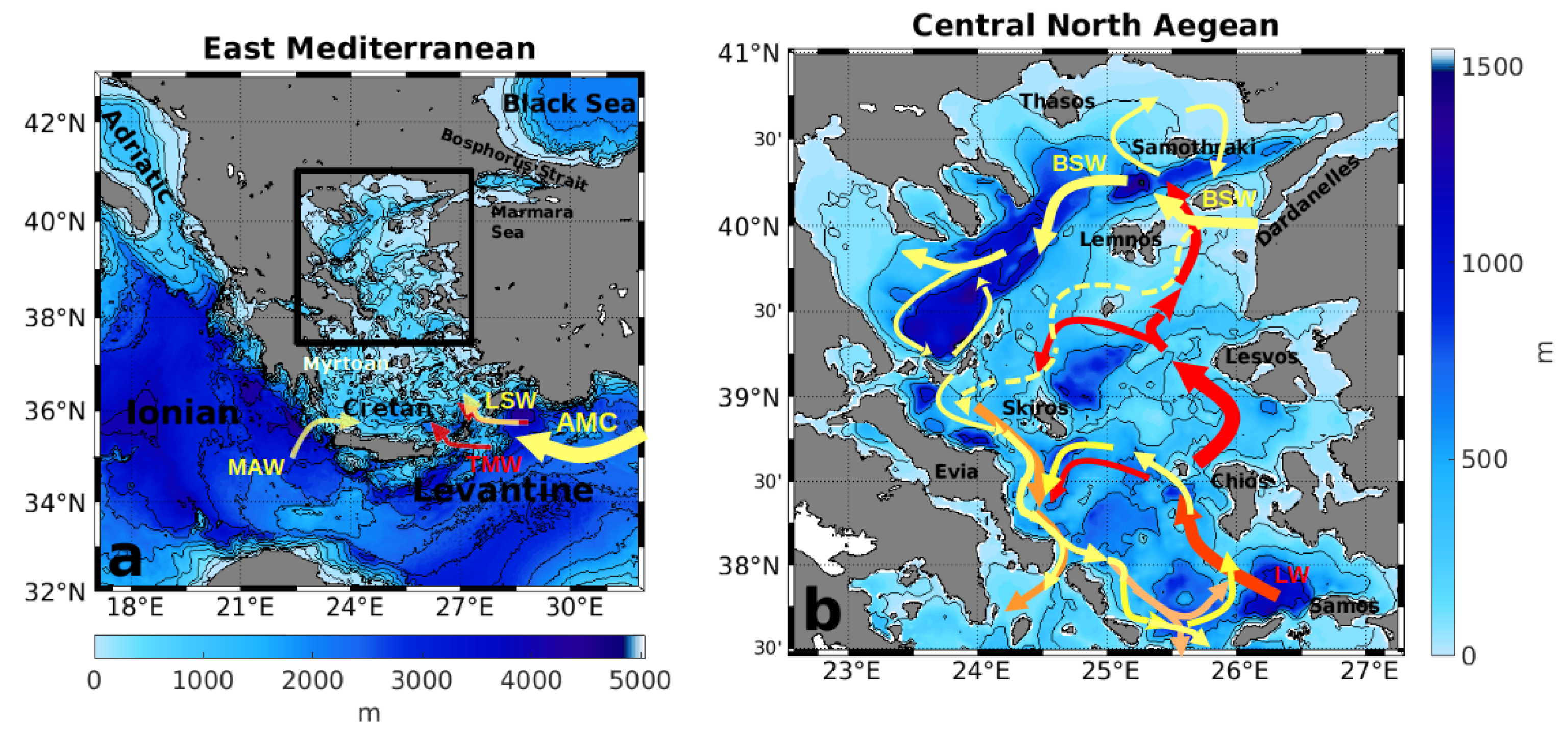
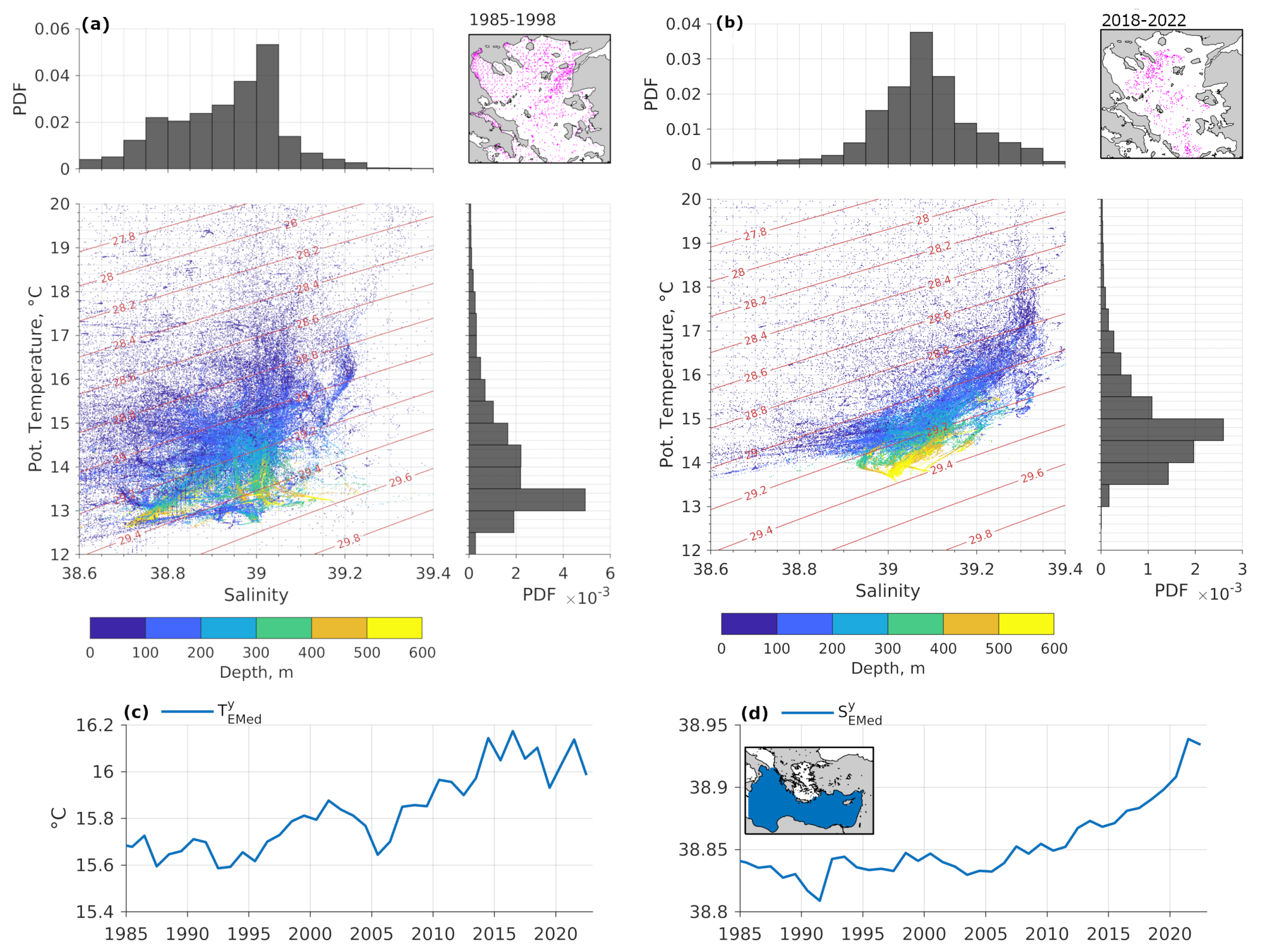
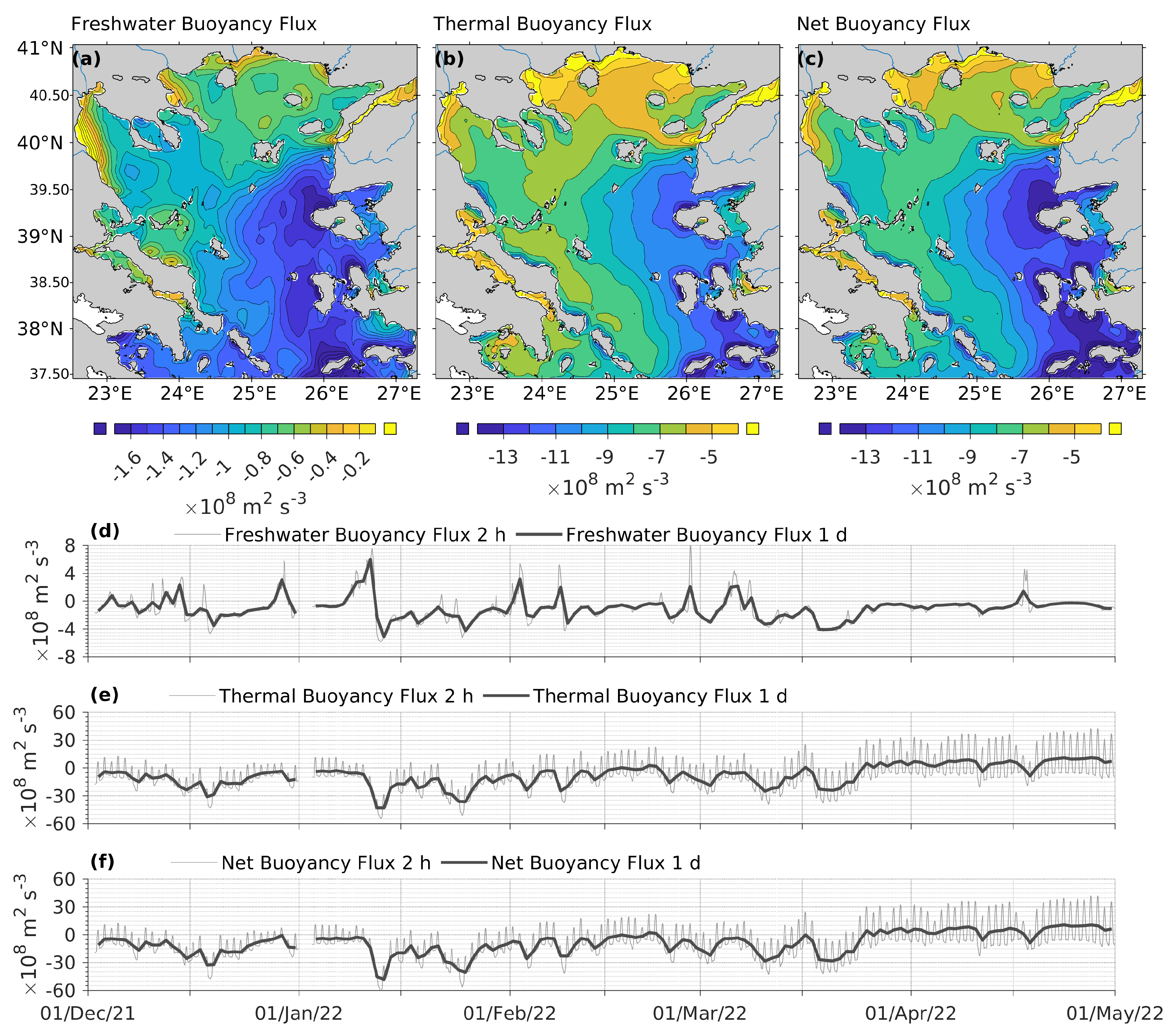
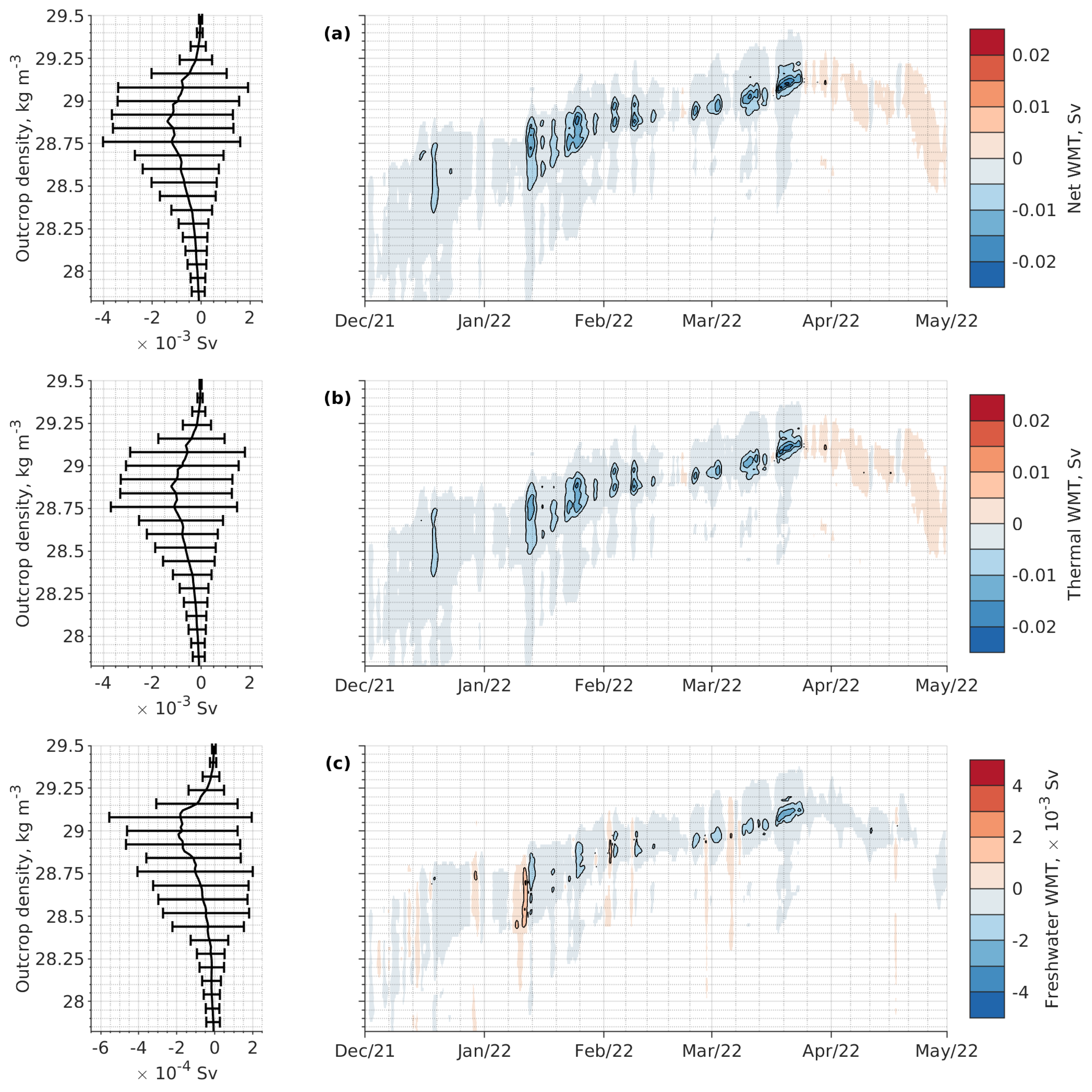
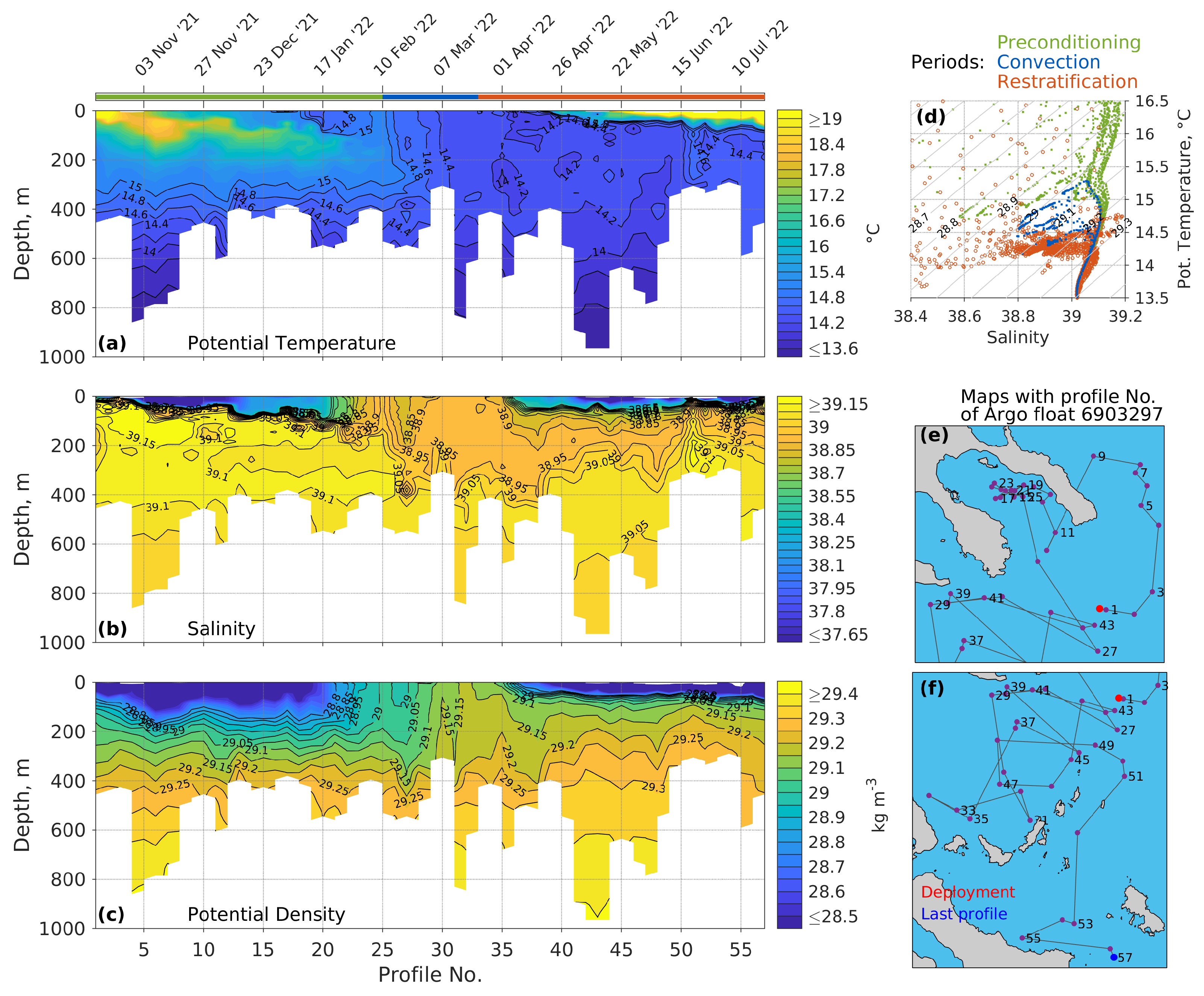

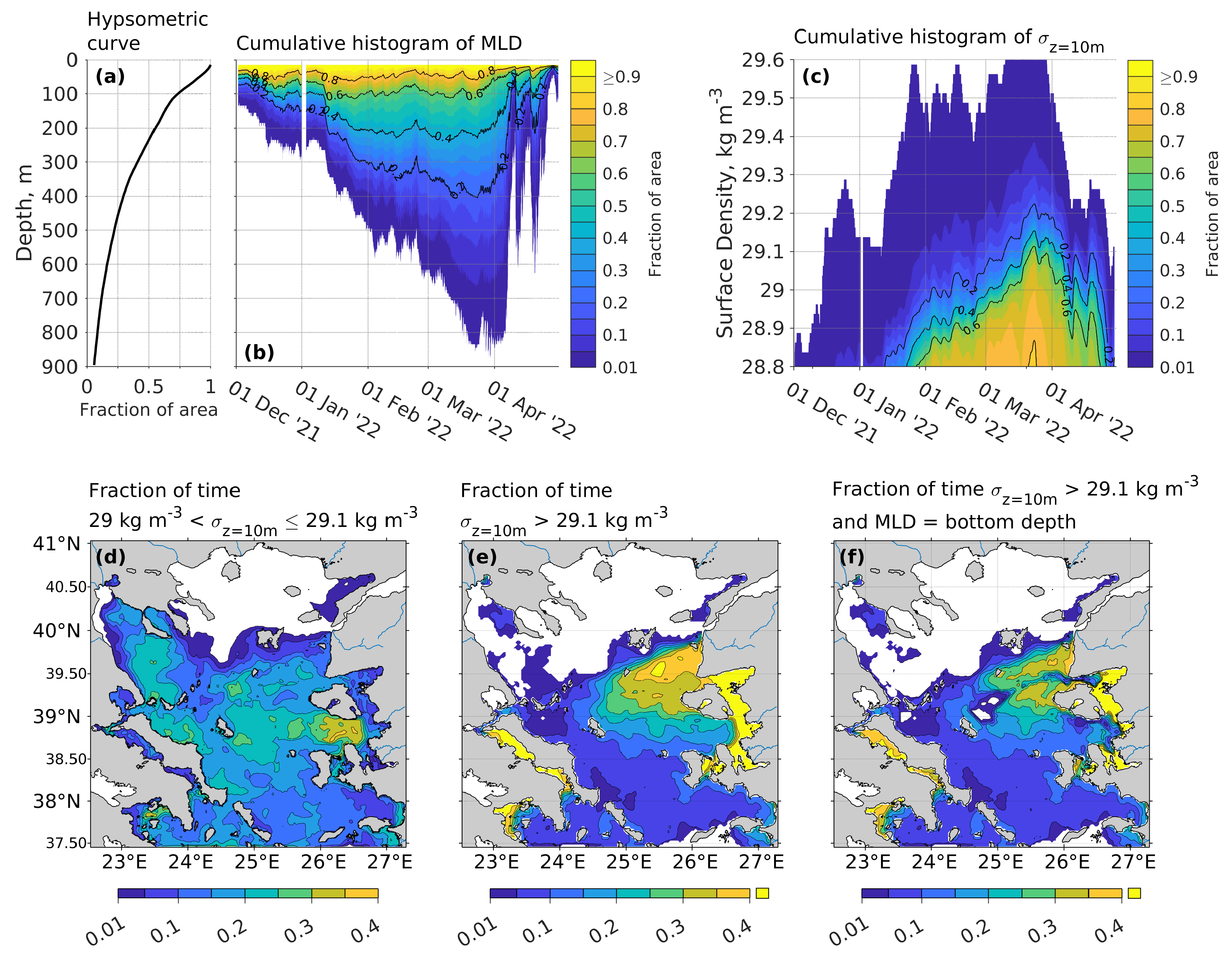
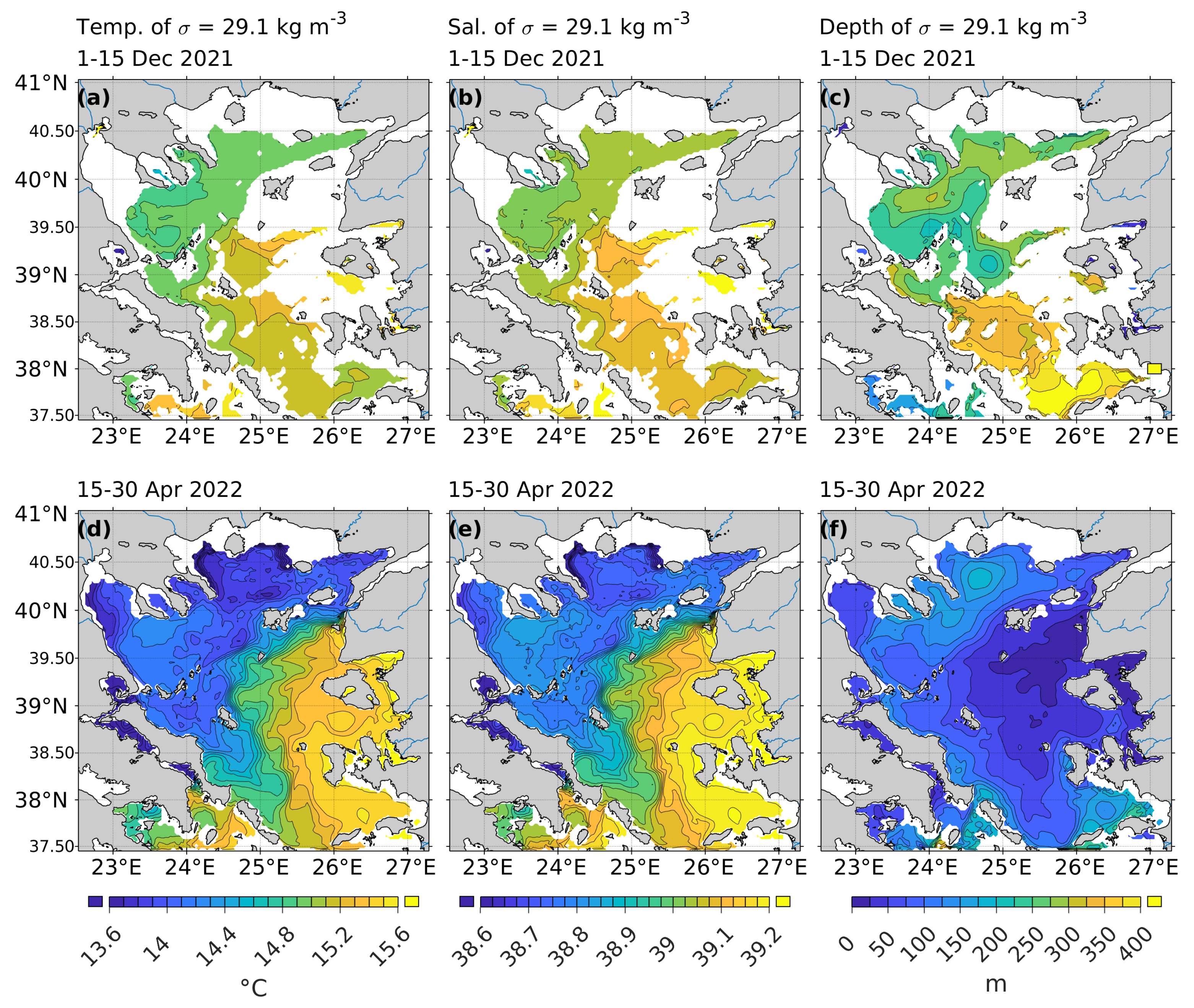
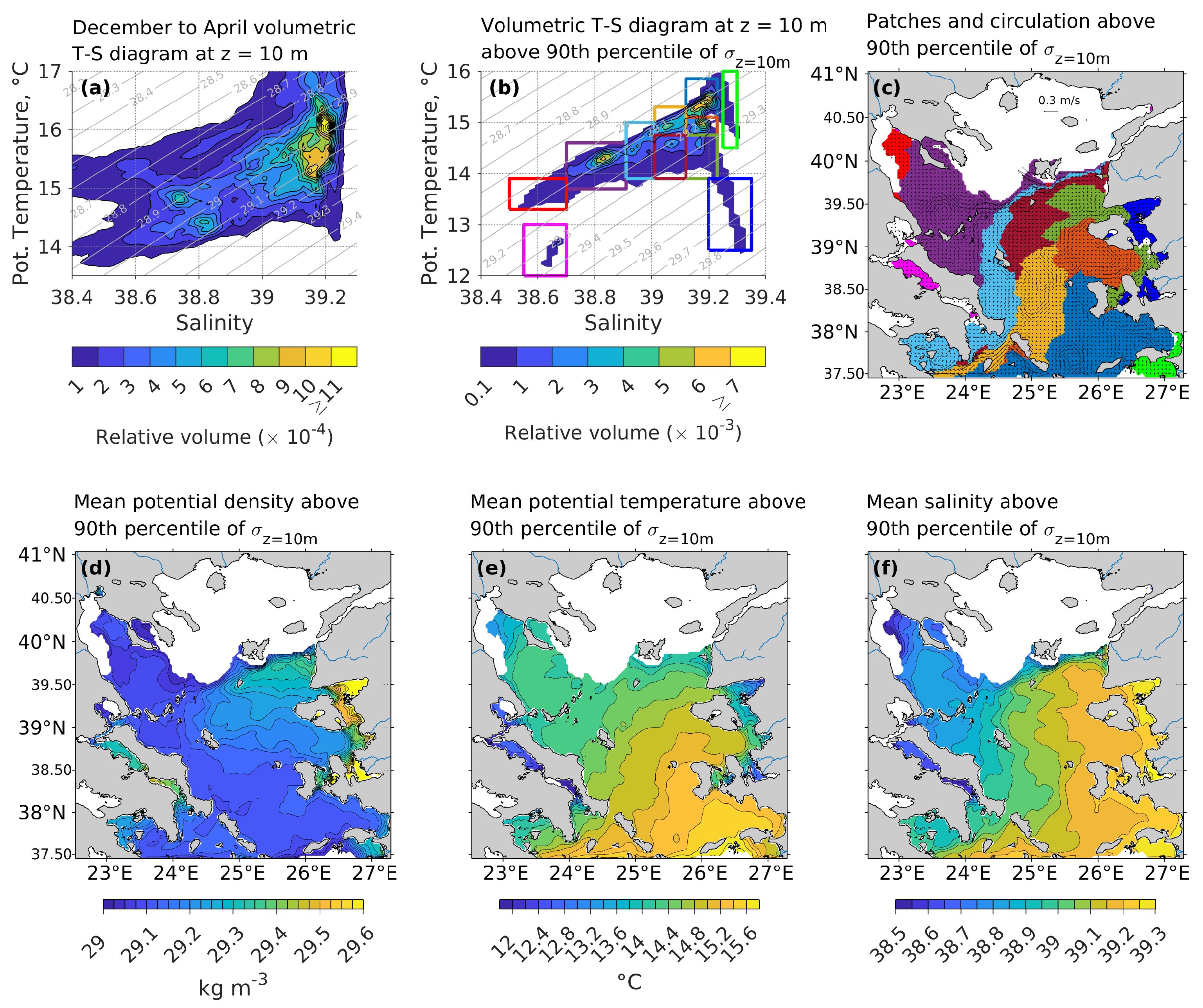
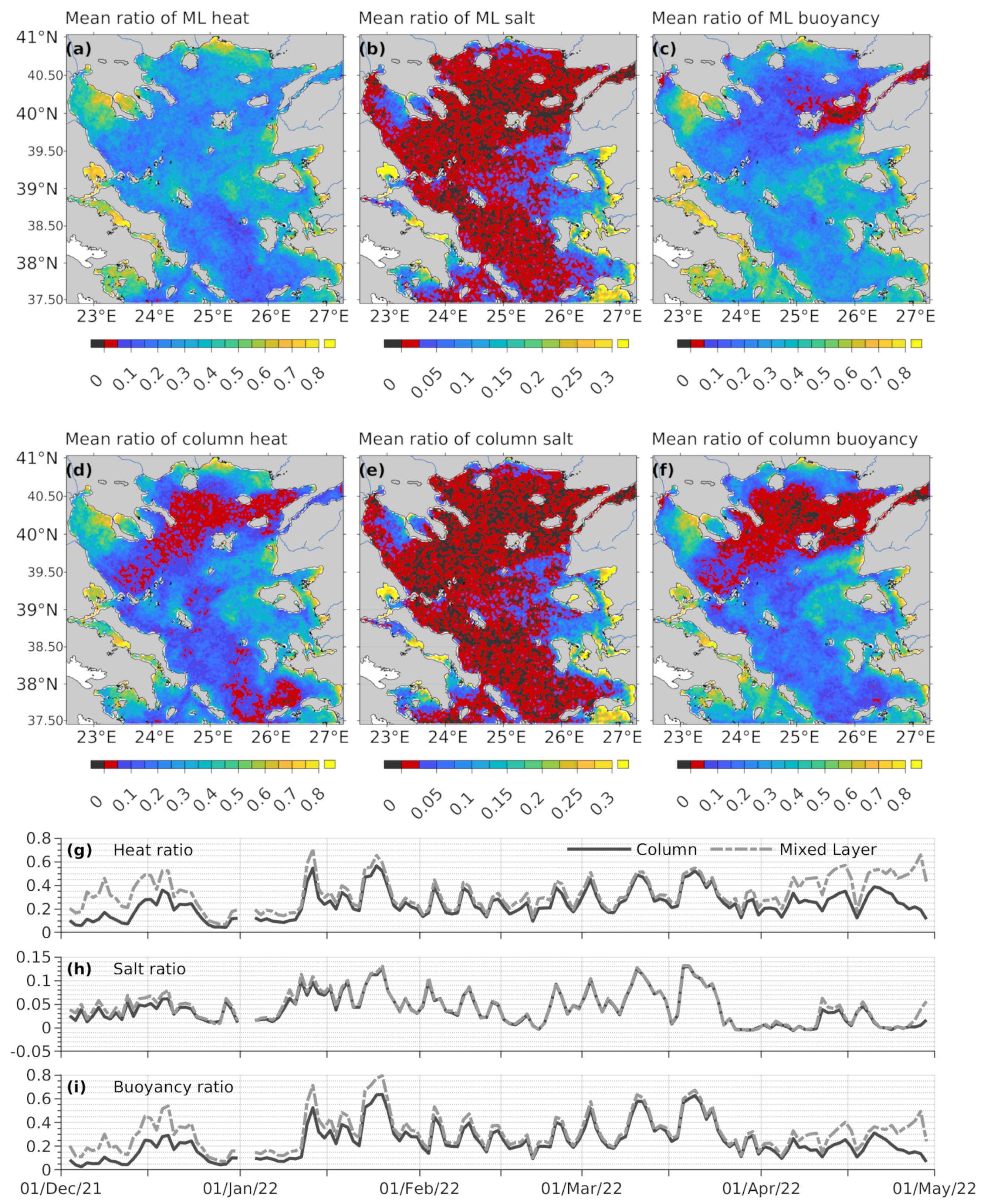
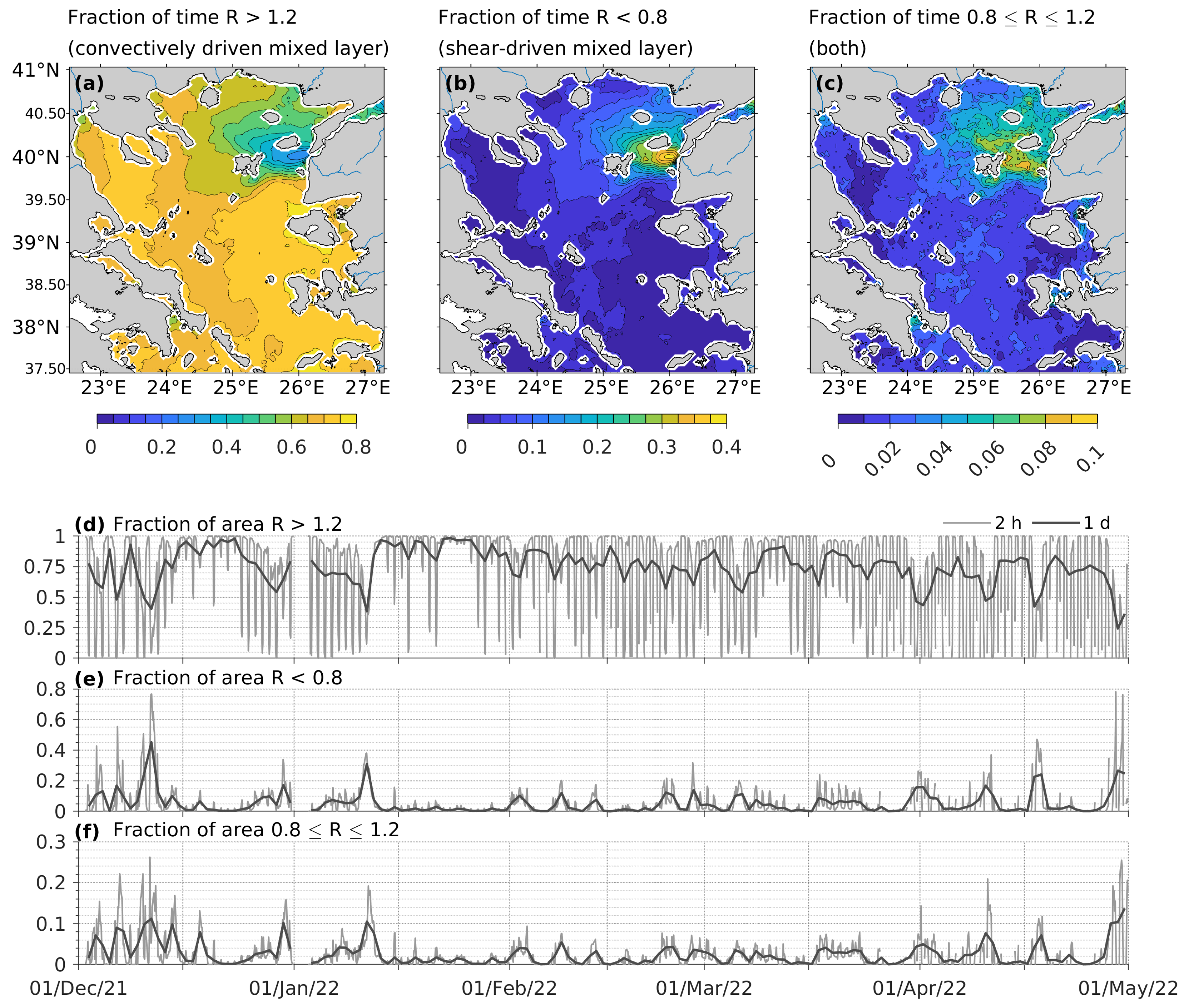
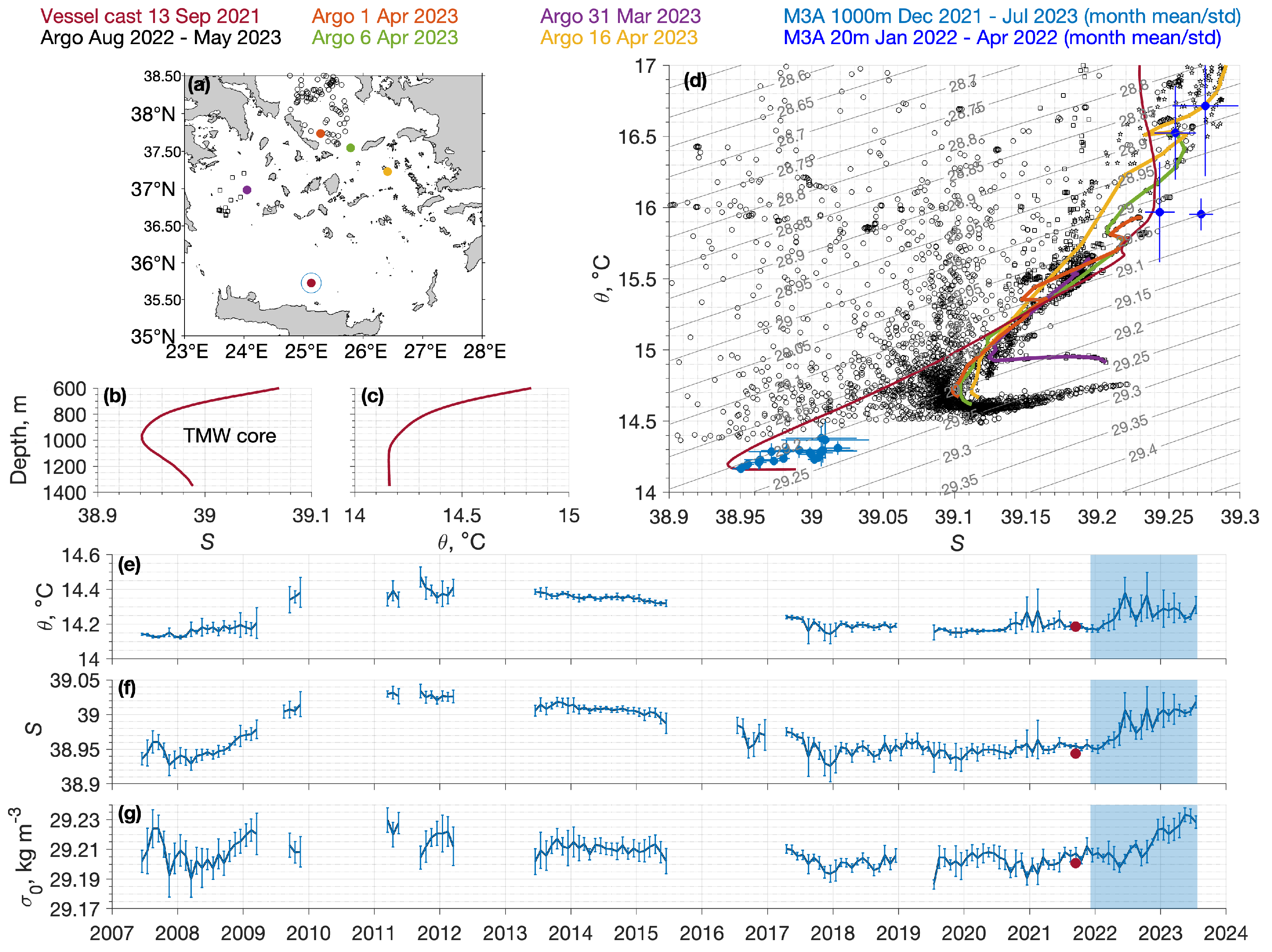
| Depth, m | , °C | S | , |
|---|---|---|---|
| 0–100 | |||
| 100–300 | |||
| 300–600 |
Disclaimer/Publisher’s Note: The statements, opinions and data contained in all publications are solely those of the individual author(s) and contributor(s) and not of MDPI and/or the editor(s). MDPI and/or the editor(s) disclaim responsibility for any injury to people or property resulting from any ideas, methods, instructions or products referred to in the content. |
© 2024 by the authors. Licensee MDPI, Basel, Switzerland. This article is an open access article distributed under the terms and conditions of the Creative Commons Attribution (CC BY) license (https://creativecommons.org/licenses/by/4.0/).
Share and Cite
Potiris, M.; Mamoutos, I.G.; Tragou, E.; Zervakis, V.; Kassis, D.; Ballas, D. Dense Water Formation in the North–Central Aegean Sea during Winter 2021–2022. J. Mar. Sci. Eng. 2024, 12, 221. https://doi.org/10.3390/jmse12020221
Potiris M, Mamoutos IG, Tragou E, Zervakis V, Kassis D, Ballas D. Dense Water Formation in the North–Central Aegean Sea during Winter 2021–2022. Journal of Marine Science and Engineering. 2024; 12(2):221. https://doi.org/10.3390/jmse12020221
Chicago/Turabian StylePotiris, Manos, Ioannis G. Mamoutos, Elina Tragou, Vassilis Zervakis, Dimitris Kassis, and Dionysios Ballas. 2024. "Dense Water Formation in the North–Central Aegean Sea during Winter 2021–2022" Journal of Marine Science and Engineering 12, no. 2: 221. https://doi.org/10.3390/jmse12020221
APA StylePotiris, M., Mamoutos, I. G., Tragou, E., Zervakis, V., Kassis, D., & Ballas, D. (2024). Dense Water Formation in the North–Central Aegean Sea during Winter 2021–2022. Journal of Marine Science and Engineering, 12(2), 221. https://doi.org/10.3390/jmse12020221








